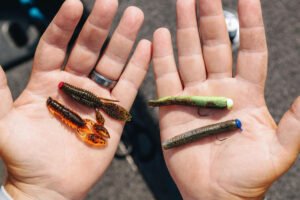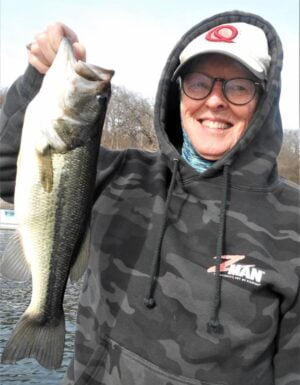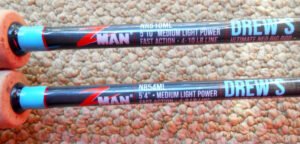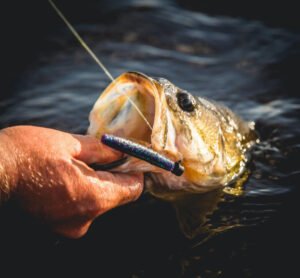
A coldwater finesse Q&A with Ned Kehde, the Ned rig maestro
While you’re reading this, huddled around the warm glow of your computer screen, Ned Kehde is almost certainly on the water. So long as one of the dozen or so of his local community reservoirs near Kansas City remain ice free, Ned will be afloat, casting his little finesse jigs, and hooking astonishing numbers of coldwater bass.
“For years, our goal was to catch 101 bass in a four-hour trip,” Ned concedes. “These days, especially on cold winter outings, we’re content to fish for two to three hours between 11am and 3pm. On average, we’re still catching about ten bass per hour—just enough bites to keep this old codger warm.”
Now nearly 83 years young, Ned still fishes more than most, adding hundreds of clicks to his well-worn fish-counter. Recently, between trips, we caught up with our friend, the legendary Ned Kehde, to talk shop and discover his latest tricks. As he’ll graciously tell you, anyone can catch bass with Midwest finesse . . .
Where are you fishing these days and what’s happening in these fisheries?

Kehde: Nowadays, we’re focusing on our many community reservoirs, catching largemouth bass on shallow water flats endowed with coontail and curly-leaf pondweed. Curly leaf, or crispus, is a winter-hardy aquatic plant that grows and produces foliage and oxygen all through the cold months. Finding either of these species can be a winter bass goldmine, especially while other anglers target submerged brushpiles and offshore structure. Contrary to the notion that coldwater bass stick to deep water, we continue catching bass in 5 to 10 feet of water all winter long.
Any differences between the lures you’re throwing now versus the warmer months?
During winter, we probably rely on lighter jigs than usual. So, we’re wielding a lot of 1/32-, 1/20-, 1/16- and 1/15-ounce jigs, mostly OG™ Mushrooms and Finesse ShroomZ™.
Affixed to these little jigs, which feature lightwire #4 hooks, favorite winter baits are Z-Man® Finesse ShadZ™, Finesse TRDs™ and TRD MinnowZ™. I usually run with five rigged rods, the other two often tied to a TRD BugZ™, TRD TicklerZ™ or shortened (2.5”) ZinkerZ™.

A lot of folks view these tiny, light jigheads and #4 hooks as unacceptably flimsy for bass, but we regularly catch 3-, 4- and occasionally 5- and 6-pound bass on these #4 hooks with no issues. Hooksets are nice and easy, with little force required to plant them firmly in a bass jaw. Moreover, these little hooks slide through and over vegetation and woodcover, rarely snagging; remember, we’re often fishing right in and among the green stuff—and with an exposed hook, no less.
Any tricks or adjustments you’re making to your baits?
Funny you should ask. I’m a huge fan of salted ElaZtech® baits and their propensity to become increasingly alluring to bass as they “age.” As a bait catches more fish and spends more time submerged, some of the salt leaches out of its body, particularly with baits like the TRD, ZinkerZ or Finesse WormZ™. Some anglers pre-soak their baits prior to hitting the water to speed the aging process. Or you can stretch them way out, which instantly sheds some of the salt.
Other anglers I know like to place their baits beneath the truck windshield while driving to the lake to soften them up even more than usual (ElaZtech is already softer than traditional PVC plastics.)
As baits age, they become increasingly buoyant (an aged ZinkerZ will actually float a 1/32-ounce jig, so we often move up to a 1/16- or 1/20-oz jighead.) Other anglers I know have noted that aged, salt impregnated ElaZtech baits develop a slimy outer texture, which they believe bass find more appetizing.

Regardless, in winter, these aged baits really shine because the increased buoyancy means reduced rate of fall and more hovering action above the vegetation— hanging right in the strike zone as you retrieve. These factors really seem to prompt bass with low metabolic rates to gobble our aged baits.
How are you retrieving your finesse baits when the water’s cold?
Just yesterday, we had 45-degree water and winds gusting to almost 40-mph. At times, you couldn’t even feel the jig. On days like this, especially when hands get cold, we do a lot of ‘strolling,’ pitching the jig out behind the boat and just moving along slow with the trolling motor. We also employ the shake-and-drag retrieve. Then, when our baits hit a sweet spot, we’ll often stop shaking the bait and just deadstick it in place—for at least several seconds (sometimes much longer). Given the buoyant bait’s ability to stand up and mimic a live invertebrate, you can almost fish it like livebait.
The light jighead and buoyant bait also provides a huge bonus when we’re fishing around vegetation. That hover factor allows us to do what we call ‘polishing the coontail,’ just sweeping the bait over the plant tops—out of snag territory and yet highly visible to bass.
Beyond some of your traditional favorites like green pumpkin, what other colors are hot?
Well, I’ve been a devotee of red jigheads for a long time. Red works everywhere.
More recently, I’ve been using a lot of baby-blue jigheads, which I often hand-paint with a special hue of fingernail polish. This eye-catching blue tone almost exactly replicates the iridescent blue gill plates on green sunfish—a key bass forage.
I couple red and blue jigheads with a lot of different bait colors. Lately been catching bass on a Purple Death pattern TRD TicklerZ. The Hot Snakes pattern has also been productive; that’s a new one for me—sort of an alternative to my old-reliable Coppertreuse.
Heard a rumor you might be testing some new finesse rods.
Can’t tell you how excited I am about these prototype spinning rods, designed by my friend and Midwest finesse guru, Drew Reese. While the rest of the fishing world continues to fish rods in the 7-foot range, these rods run 5’4” and 5’10”. They’re the lightest, most sensitive rods I’ve fished since hefting classic G Loomis jig rods designed by Ray Fincke, propreitor of a renowned tackle shop in Rosedale, Kansas.
The 5’4” is also proving to be a fantastic crappie rod, especially with the new Micro Finesse baits. We’ll be casting these microbaits a lot more, once water temps dip into the low 40s.

When you fish as often as we do, it’s a gift to cast with something light enough to eliminate fatigue. Coupled with 4-pound test Berkley Fireline and a 5-foot fluorocarbon leader, these compact, featherlight sticks perfectly fit Midwest finesse retrieves, such as swim-glide-shake. We’re also catching a lot of fish now by working the bait right beneath the boat. These shorter rods give us more vertical control and a super direct connection between your hands and the lure. They greatly enhance presentation and bite detection in wind, as well.
Drew and I think Midwest finesse devotees are really going to love these rods. Though it’ll be a few months yet before folks can get theirs. Hopefully, just in time for spring!

 About Z-Man Fishing Products: A dynamic Charleston, South Carolina based company, Z-Man Fishing Products has melded leading edge fishing tackle with technology for nearly three decades. Z-Man has long been among the industry’s largest suppliers of silicone skirt material used in jigs, spinnerbaits and other lures. Creator of the Original ChatterBait®, Z-Man is also the renowned innovators of 10X Tough ElaZtech softbaits, fast becoming the most coveted baits in fresh- and saltwater. Z-Man is one of the fastest-growing lure brands worldwide.
About Z-Man Fishing Products: A dynamic Charleston, South Carolina based company, Z-Man Fishing Products has melded leading edge fishing tackle with technology for nearly three decades. Z-Man has long been among the industry’s largest suppliers of silicone skirt material used in jigs, spinnerbaits and other lures. Creator of the Original ChatterBait®, Z-Man is also the renowned innovators of 10X Tough ElaZtech softbaits, fast becoming the most coveted baits in fresh- and saltwater. Z-Man is one of the fastest-growing lure brands worldwide.

